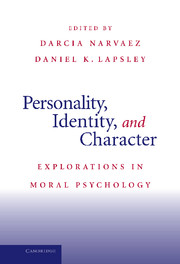Book contents
- Frontmatter
- Contents
- Contributors
- Introduction
- 1 The Moral Personality
- 2 The Moral Functioning of the Person as a Whole: On Moral Psychology and Personality Science
- 3 Moral Science? Still Metaphysical After All These Years
- 4 Cultural Pluralism and Moral Identity
- 5 Neuroscience and Morality: Moral Judgments, Sentiments, and Values
- 6 Triune Ethics Theory and Moral Personality
- 7 Early Foundations: Conscience and the Development of Moral Character
- 8 The Development of the Moral Personality
- 9 Urban Neighborhoods as Contexts for Moral Identity Development
- 10 Moral Personality Exemplified
- 11 Greatest of the Virtues? Gratitude and the Grateful Personality
- 12 The Elusive Altruist: The Psychological Study of the Altruistic Personality
- 13 Growing Toward Care: A Narrative Approach to Prosocial Moral Identity and Generativity of Personality in Emerging Adulthood
- 14 Moral Identity, Integrity, and Personal Responsibility
- 15 The Dynamic Moral Self: A Social Psychological Perspective
- 16 The Double-Edged Sword of a Moral State of Mind
- 17 Moral Identity in Business Situations: A Social-Cognitive Framework for Understanding Moral Functioning
- 18 The Moral Functioning of Mature Adults and the Possibility of Fair Moral Reasoning
- 19 Moral Personality: Themes, Questions, Futures
- Author Index
- Subject Index
5 - Neuroscience and Morality: Moral Judgments, Sentiments, and Values
Published online by Cambridge University Press: 05 June 2012
- Frontmatter
- Contents
- Contributors
- Introduction
- 1 The Moral Personality
- 2 The Moral Functioning of the Person as a Whole: On Moral Psychology and Personality Science
- 3 Moral Science? Still Metaphysical After All These Years
- 4 Cultural Pluralism and Moral Identity
- 5 Neuroscience and Morality: Moral Judgments, Sentiments, and Values
- 6 Triune Ethics Theory and Moral Personality
- 7 Early Foundations: Conscience and the Development of Moral Character
- 8 The Development of the Moral Personality
- 9 Urban Neighborhoods as Contexts for Moral Identity Development
- 10 Moral Personality Exemplified
- 11 Greatest of the Virtues? Gratitude and the Grateful Personality
- 12 The Elusive Altruist: The Psychological Study of the Altruistic Personality
- 13 Growing Toward Care: A Narrative Approach to Prosocial Moral Identity and Generativity of Personality in Emerging Adulthood
- 14 Moral Identity, Integrity, and Personal Responsibility
- 15 The Dynamic Moral Self: A Social Psychological Perspective
- 16 The Double-Edged Sword of a Moral State of Mind
- 17 Moral Identity in Business Situations: A Social-Cognitive Framework for Understanding Moral Functioning
- 18 The Moral Functioning of Mature Adults and the Possibility of Fair Moral Reasoning
- 19 Moral Personality: Themes, Questions, Futures
- Author Index
- Subject Index
Summary
What makes people recoil upon witnessing human tragedies, engage in costly helping behaviors, and violently protest against acts of injustice (Goodenough & Prehn, 2004; Zeki & Goodenough, 2004)? Strikingly, this inclination can go far beyond the interpersonal sphere, as humans often risk material resources, and even physical integrity, to uphold culturally shaped values in the form of societal causes, ideologies, or beliefs, for example. Moral and social values form the basis of personal and sociocultural identities, which is a core theme throughout this volume. It is thus not surprising that debates on the moral nature of humanity have occupied theologians, philosophers, and laymen for millennia. Here we will review how neuroscience is providing new insights on how the human brain enables complex moral cognition and behavior.
Defining morality is not a straightforward task, and any definition will suffer from shortcomings, especially when evaluated by scholars from different fields. The words “moral” (derived from the Latin moralis) and “ethical” (from the Greek êthikos) originally referred to the consensus of manners and customs (MacIntyre, 1985). This rather broad meaning of “moral,” however, does not address a central question for the cognitive neuroscience of morality: What distinguishes moral cognition from other forms of socially relevant abilities? Most instances of social behavior are morally relevant because they have effects on others and are thus liable to be evaluated as “right” or “wrong” depending on socioculturally shaped norms. Therefore, one may argue that on the outside, any kind of social behavior is also moral in nature and that the neural and cognitive mechanisms guiding moral and social behavior should therefore be identical.
- Type
- Chapter
- Information
- Personality, Identity, and CharacterExplorations in Moral Psychology, pp. 106 - 135Publisher: Cambridge University PressPrint publication year: 2009
- 6
- Cited by



